AMD Radeon HD 7970 Review: 28nm And Graphics Core Next, Together As One
by Ryan Smith on December 22, 2011 12:00 AM EST- Posted in
- GPUs
- AMD
- Radeon
- ATI
- Radeon HD 7000
DiRT 3
For racing games our racer of choice continues to be DiRT, which is now in its 3rd iteration. Codemasters uses the same EGO engine between its DiRT, F1, and GRID series, so the performance of EGO is has been relevant for a number of number of racing games over the years.
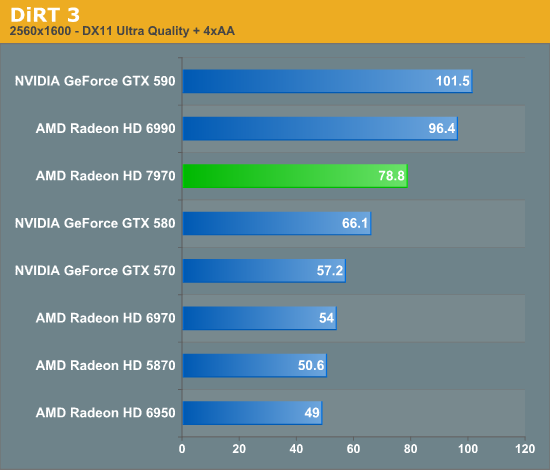
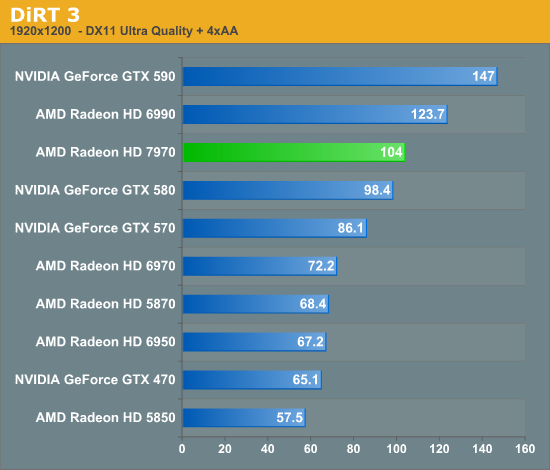
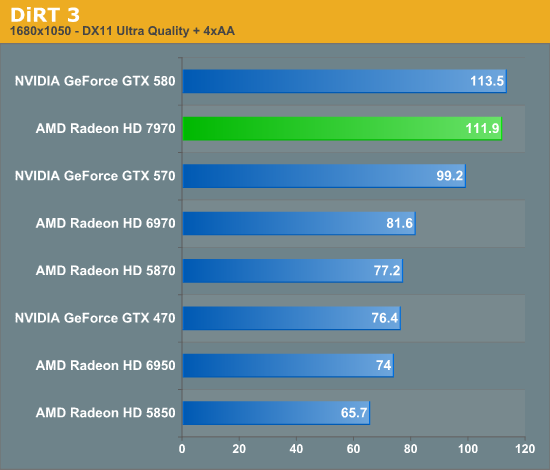
With DiRT 2 NVIDIA often held a slight edge in performance, and due to the reuse of the EGO engine this hasn’t really changed in DiRT 3. As a result the 7970 is still faster than the GTX 580, but not by as much as in other games. At 2560 this manifests itself as a 19% lead, while at 1920 it’s down to 6%, and embarrassingly enough at 1680 the 7970 actually falls behind the GTX 580 by just a hair. DiRT 3 is not particularly shader heavy so that may be part of the reason that the 7970 can’t easily clear the GTX 580 here, but that doesn’t fully explain what we’re seeing. At the end of the day this is all academic since everything north of the GTX 570 can clear 60fps even at 2560, but it would be nice to eventually figure out why NVIDIA does better than average here.
Meanwhile compared to the 6970 the 7970 enjoys one of its bigger leads. Here the 7970 leads by about 45% at 2560 and 1920, and finally falls slightly to 37% at 1680.

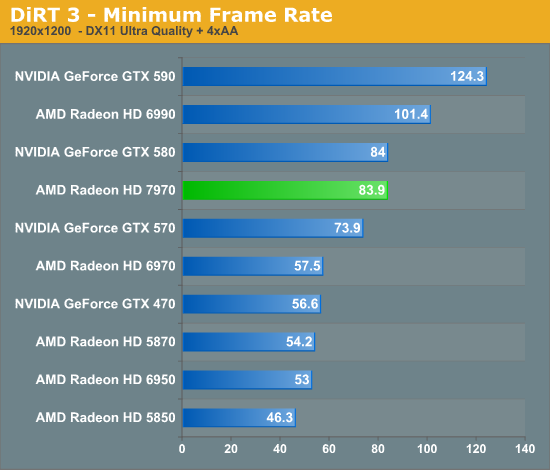
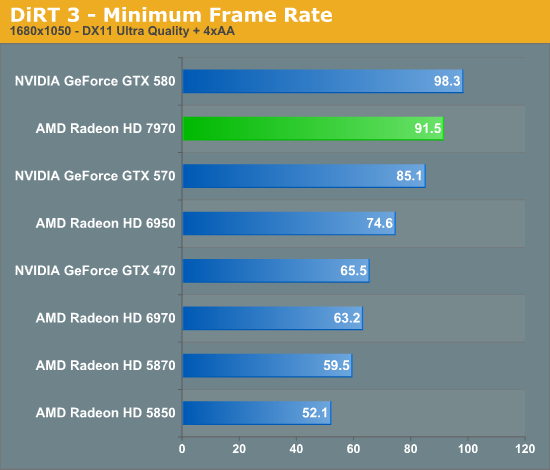
We’ve had a number of requests for more minimum framerates throughout the years, so we’re also going to include the minimum framerates for DiRT 3 as the minimums have proven to be reliably consistent in our benchmarks.
Given that the 7970 was already seeing a smaller than typical lead over the GTX 580, it’s not wholly surprising to see that it fares a bit worse when it comes to minimums. At 2560 its minimum framerate of 64.2fps means that the 7970 will deliver smooth performance every last moment, but at the same time this is only 11% better than the GTX 580. At 1920 this becomes a dead heat between the two cards. Meanwhile compared to the 6970 the 7970 is always about 45% ahead.










292 Comments
View All Comments
mczak - Thursday, December 22, 2011 - link
Oh yes _for this test_ certainly 32 ROPs are sufficient (FWIW it uses FP16 render target with alpha blend). But these things have caches (which they'll never hit in the vantage fill test, but certainly not everything will have zero cache hits), and even more important than color output are the z tests ROPs are doing (which also consume bandwidth, but z buffers are highly compressed these days).You can't really say if 32 ROPs are sufficient, nor if they are somehow more efficient judged by this vantage test (as just about ANY card from nvidia or amd hits bandwidth constraints in that particular test long before hitting ROP limits).
Typically it would make sense to scale ROPs along with memory bandwidth, since even while it doesn't need to be as bad as in the color fill test they are indeed a major bandwidth eater. But apparently AMD disagreed and felt 32 ROPs are enough (well for compute that's certainly true...)
cactusdog - Thursday, December 22, 2011 - link
The card looks great, undisputed win for AMD. Fan noise is the only negative, I was hoping for better performance out the new gen cooler but theres always non-reference models for silent gaming.Temps are good too so theres probably room to turn the fan speed down a little.
rimscrimley - Thursday, December 22, 2011 - link
Terrific review. Very excited about the new test. I'm happy this card pushes the envelope, but doesn't make me regret my recent 580 purchase. As long as AMD is producing competitive cards -- and when the price settles on this to parity with the 580, this will be the market winner -- the technology benefits. Cheers!nerfed08 - Thursday, December 22, 2011 - link
Good read. By the way there is a typo in final words.faster and cooler al at once
Anand Lal Shimpi - Thursday, December 22, 2011 - link
Fixed, thank you :)Take care,
Anand
hechacker1 - Thursday, December 22, 2011 - link
I think most telling is the minimum FPS results. The 7970 is 30-45% ahead of the previous generation; in a "worse case" situation were the GPU can't keep up or the program is poorly coded.Of course they are catching up with Nvidia's already pretty good minimum FPS, but I am glad to see the improvement, because nothing is worse than stuttering during a fasted pace FPS. I can live with 60fps, or even 30fps, as long as it's consistent.
So I bet the micro-stutter problem will also be improved in SLI with this architecture.
jgarcows - Thursday, December 22, 2011 - link
While I know the bitcoin craze has died down, I would be interested to see it included in the compute benchmarks. In the past, AMD has consistently outperformed nVidia in bitcoin work, it would also be interesting to see Anandtech's take as to why, and to see if the new architecture changes that.dcollins - Thursday, December 22, 2011 - link
This architecture will most likely be a step backwards in terms of bitcoin mining performance. In the GCN architecture article, Anand mentioned that buteforce hashing was one area where a VLIW style architecture had an advantage over a SIMD based chip. Bitcoin mining is based on algorithms mathematically equivalent to password hashing. With GCN, AMD is changing the very thing that made their card better miners than Nvidia's chips.The old architecture is superior for "pure," mathematically well defined code while GCN is targeted at "messy," more practical and thus widely applicable code.
wifiwolf - Thursday, December 22, 2011 - link
a bit less than expected, but not really an issue:http://www.tomshardware.co.uk/radeon-hd-7970-bench...
dcollins - Thursday, December 22, 2011 - link
You're looking at a 5% increase in performance for a whole new generation with 35% more compute hardware, increased clock speed and increased power consumption: that's not an improvement, it's a regression. I don't fault AMD for this because Bitcoin mining is a very niche use case, but Crossfire 68x0 cards offer much better performance/watt and performance/$.